- EN - English
- CN - 中文
Metabolomic and Lipidomic Analysis of Bone Marrow Derived Macrophages
骨髓衍生巨噬细胞的代谢组学和脂质组学分析
发布: 2020年07月20日第10卷第14期 DOI: 10.21769/BioProtoc.3693 浏览次数: 8745
评审: Parul MehrotraMarco LeporeAnonymous reviewer(s)
Abstract
Macrophages are highly plastic immune cells that are capable of adopting a wide array of functional phenotypes in response to environmental stimuli. The changes in macrophage function are often supported and regulated by changes in cellular metabolism. Capturing a comprehensive picture of metabolism is vital for understanding the role of metabolic rewiring in the immune response. Here we present a method for systematically quantifying the abundance of metabolites and lipids in primary murine bone marrow derived macrophages (BMDMs). This method simultaneously extracts polar metabolites and lipids from BMDMs using a rapid two-phase extraction procedure. The polar metabolite fraction and lipid fraction are subsequently analyzed by separate liquid chromatography-mass spectrometry (LC-MS) methods for optimized coverage and quantification. This allows for a comprehensive characterization of cellular metabolism that can be used to understand the impact of a variety of environmental stimuli on macrophage metabolism and function.
Keywords: LC-MS (液质联用)Background
Macrophages, cells of the innate immune system, can adopt a multitude of functional phenotypes in response to cues within the local microenvironment. The activation of macrophages is coupled to, and highly reliant on, specific reprograming of cellular metabolism (Tannahill et al., 2013; Galván-Peña and O’Neill, 2014; Jha et al., 2015; Kelly and O'Neill, 2015; Cordes et al., 2016; Mills and O'Neill 2016; et al.; Mills et al., 2016; Liu et al., 2013; Lampropoulou et al., 2016; Van den Bossche et al., 2017; Williams et al., 2018; Martin et al., 2017). The metabolic reprogramming is wide-spread, involving changes in central metabolism, amino acid metabolism, and lipid remodeling (Galván-Peña and O’Neill, 2014; O’Neill and Pearce, 2016; Van den Bossche et al., 2017). These changes in different pathways are interdependent, allowing cells to produce energy, signaling molecules (e.g., eiconsanoids), and effector molecules (e.g., nitric oxide and reactive oxygen species) for immune functions. Systematic profiling of metabolites and lipids is an important tool to further understand the role these biomolecules play in macrophages.
Development of metabolomic and lipidomic methods has enabled reliable quantification of hundreds of metabolites and lipids simultaneously (Fiehn, 2002; Wenk, 2005). This protocol presents a method for isolation of murine bone marrow derived macrophages (BMDMs), extraction of their lipids and small molecule metabolites and subsequent quantification of their abundance using liquid chromatography–mass spectrometry (LC-MS). BMDMs are a frequently used model for understanding macrophage function and metabolism. Adaptation of the “BUME (butanol and methanol)” extraction method (Löfgren et al., 2012 and 2016), allows for simple and quick extraction of a wide range of both polar metabolites and lipids from a single sample of BMDMs. This reduces variability and gives good recovery. The cell extracts are analyzed by LC-MS, which provides the sensitivity and selectivity required for metabolomic and lipidomic analyses (Theodoridis et al., 2012; Gika et al., 2014). Utilization of parallel LC-MS methods for separate analysis of metabolites and lipids, as outlined in this protocol, provides the broad coverage of the metabolome and lipidome. The LC-MS data are then analyzed using previously developed and publically available analysis tools, MAVEN and LipiDex, giving confident identification and quantification of a wide range metabolite and lipid species (Melamud et al., 2010; Clasquin et al., 2012; Hutchins et al., 2018).
This method can be used to characterize how metabolism in macrophages is altered in response to different stimuli, and how it may be regulated by other microenviromental factors (e.g., nutrient availability). This LC-MS based metabolomics and lipidomics method can be further coupled with isotopic tracing approaches to determine the changes in metabolic flux during immune response, elucidate the mechanisms controlling metabolic rewiring, and facilitate the investigation of the mechanisms connecting altered metabolism to broader macrophage functions.
Materials and Reagents
- Isolation and culture of BMDM
- 27½ G needle (BD Biosciences, catalog number: 305109 )
- 10 ml plastic disposable syringe (Thermo Scientific, catalog number: S7515-10 )
- 70 μm cell strainer (Thermo Fisher Scientific, catalog number: 0 87712 )
- 0.45 μm PES filter unit (Thermo Fisher Scientific, catalog number: 162-0045 )
- 50 ml conical tubes (Thermo Fisher Scientific, catalog number: 339652 )
- Countess cell counting chambers (Invitrogen, catalog number: C10283 )
- Petri dishes (Fisherbrand, catalog number: FB0875712 )
- 6-well culture plates (Eppendorf, catalog number: 00 30720113 )
- 175 cm2 flasks (Eppendorf, catalog number: 00 30710029 )
- Sterile top filters (Nalgene, catalog number: 596-3320 )
- Cell scraper (Corning, catalog number: 3008 )
- 6+ weeks old mouse (C57BL/6J, Jackson Laboratory)*
- L929 cells (ATCC®, catalog number: CCL-1TM)
- 0.4% Trypan blue stain (Gibco, catalog number: 15250-061 )
- 70% Ethanol (Pharmco, catalog number: 1110002000 )
- DMEM High Glucose Medium (Sigma-Aldrich, catalog number: D1152 )
- Penicillin Streptomycin (Thermo Fisher Scientific, catalog number: 15-140-122 )
- Fetal Bovine Serum (FBS, Hyclone, catalog number: 89133-098 )
- Dialyzed Fetal Bovine Serum (dFBS, Hyclone, catalog number: 16777-212 )
- Recombinant mouse macrophage colony stimulating factor (mCSF, R&D Systems, catalog number: 416ML050 )
- RPMI 1640 Medium without Glutamine (Hyclone, catalog number: SH30096.01 )
- Glutamine (Thermo Fisher, catalog number: BP379-100 )
- HEPES (VWR, catalog number: 16777-032 )
- Lipopoylsaccharide from E. coli O111:B4 (LPS, Sigma-Aldrich, catalog number: L3024 )**
- Interferon-γ (IFNγ, R&D Systems, catalog number: 485-MI-100 )**
- Accutase (STEMCell Technologies, catalog number: 0 7922 )
- Trypsin-EDTA (0.05%) (Thermo Fisher Scientific, catalog number: 25300062 )
- Phosphate buffered saline (Thermo Fisher Scientific, catalog number: 14190144 )
- L929 conditioned media (see Recipes)
- BMDM maintenance media (see Recipes)
- BMDM differentiation media (see Recipes)
- L929 culture media (see Recipes)
- *Any mouse model with sufficiently healthy bone marrow can be used.
- **Optional based on desired stimulation protocol. LPS and IFN-γ stimulation will induce classical activation.
- Metabolite and Lipid Extraction and Sample Preparation
- Pipette tips 1,000 μl, 200 μl (VWR, catalog numbers: 89079-470 , 89079-478)
- 1.5 ml plastic tube (VWR, catalog number: 89000-028 )
- Glass bottles (used for LC-MS grade solvents only, see Notes)
- LC-MS polypropylene vials (Thermo Fisher Scientific, catalog number: 03-377-299 )
- LC-MS glass vials (Thermo Fisher Scientific, catalog number: 03-FIRVA )
- Snap caps (Thermo Fisher Scientific, catalog number: C4011-53 )
- Polypropylene microcentrifuge tubes (VWR, catalog number: 89000-028 )
- Glass vials (Wheaton, catalog number: 224740 )
- Nitrogen gas
- 1-Butanol LC-MS grade (Sigma-Aldrich, catalog number: 34867 )
- Methanol LC-MS grade (Fisher Chemical, catalog number: A456-4 )
- n-Heptane LC-MS grade (Sigma-Aldrich, catalog number: 1036541000 )
- Ethyl acetate LC-MS grade (Fisher Scientific, catalog number: E195-4 )
- Acetic acid LC-MS grade (Fisher Chemical, catalog number: A11350 )
- Water LC-MS grade (Thermo Fisher Scientific, catalog number: W64 )
- Tributylamine (Sigma-Aldrich, catalog number: 90780 )
- Ammonium Acetate LC-MS grade (Fisher Scientific, catalog number: A114-50 )
- Acetonitrile LC-MS grade (Thermo Fisher Scientific, catalog number: A955-4 )
- Isopropanol (Thermo Fisher Scientific, catalog number: A461-4 )
- SPLASH LipidoMIX Internal Standard (Avanti Polar Lipids, catalog number: 330707 )
- Ice
- LC-MS Analysis
- Acquity UPLC BEH C18 Column, 130Å, 1.7 µm, 2.1 mm x 100 mm (Waters, catalog number: 186002352 )
- Acquity UPLC BEH C18 VanGuard Pre-column, 130Å, 1.7 µm, 2.1 mm x 5 mm (Waters, catalog number: 186003975 )
- Acquity UPLC CSH C18 Column, 130Å, 1.7 µm, 2.1 mm x 100 mm (Waters, catalog number: 186005297 )
- Acquity UPLC CSH C18 VanGuard Pre-column, 130Å, 1.7 µm, 2.1 mm x 5 mm (Waters, catalog number: 186005303 )
- Solvent B (100% LC-MS grade methanol)
- Solvent A (see Recipes)
- Solvent C (see Recipes)
- Solvent D (see Recipes)
Equipment
- Surgery Scissors (Fisherbrand, catalog number: 08-935 )
- Surgery Forceps (BrainTree Scientific, catalog number: FC03-41 )
- Thermo Q-Exactive Quadrupole Orbitrap Mass Spectrometer (Thermo Scientific) coupled to a Vanquish Horizon UHPLC (Thermo Scientific)
- Nitrogen Stream Sample Concentrator (Techne, catalog number: FSC400D ), equipped with 127 mm needles (Techne, catalog number: F7210 )
- Vortexer (VWR, catalog number: 10153-838 )
- Micro Centrifuge (Beckman Coulter, model: Microfuge 20 , catalog number: B31599 )
- Benchtop Centrifuge (Thermo, model: IEC Centra CL2 )
- -20 °C Freezer
- 4 °C Fridge
- Standard Fume Hood
- Pipettes (P1000, P200)
- Sterile Cell Culture Hood
- Cell Incubator (37 °C, 5% CO2)
- Countess II Cell Counter (AMQAX1000)
Software
- Thermo Scientific XCalibur 4.1
- MAVEN (v. 682) (http://genomics-pubs.princeton.edu/mzroll/index.php) (Melamud et al., 2010; Clasquin et al., 2012)
- MZMine2 (http://mzmine.github.io/) (Pluskal et al., 2010)
- MSConvertGUI (ProteoWizard, http://proteowizard.sourceforge.net/download.html) (Kessner et al., 2008)
- LipiDex (https://github.com/coongroup/LipiDex) (Hutchins et al., 2018)
Procedure
文章信息
版权信息
© 2020 The Authors; exclusive licensee Bio-protocol LLC.
如何引用
Seim, G. L., John, S. V. and Fan, J. (2020). Metabolomic and Lipidomic Analysis of Bone Marrow Derived Macrophages. Bio-protocol 10(14): e3693. DOI: 10.21769/BioProtoc.3693.
分类
免疫学 > 免疫细胞分离 > 巨噬细胞
系统生物学 > 代谢组学 > 生物流体
细胞生物学 > 细胞新陈代谢 > 脂质
您对这篇实验方法有问题吗?
在此处发布您的问题,我们将邀请本文作者来回答。同时,我们会将您的问题发布到Bio-protocol Exchange,以便寻求社区成员的帮助。
提问指南
+ 问题描述
写下详细的问题描述,包括所有有助于他人回答您问题的信息(例如实验过程、条件和相关图像等)。
Share
Bluesky
X
Copy link




.jpg)









![基于气相色谱-[Orbitrap] 质谱的人血样本代谢物分析的自动化顺序衍生化方法](https://en-cdn.bio-protocol.org/imageup/arcimg/20250107224024942.jpg?t=1765795343)
